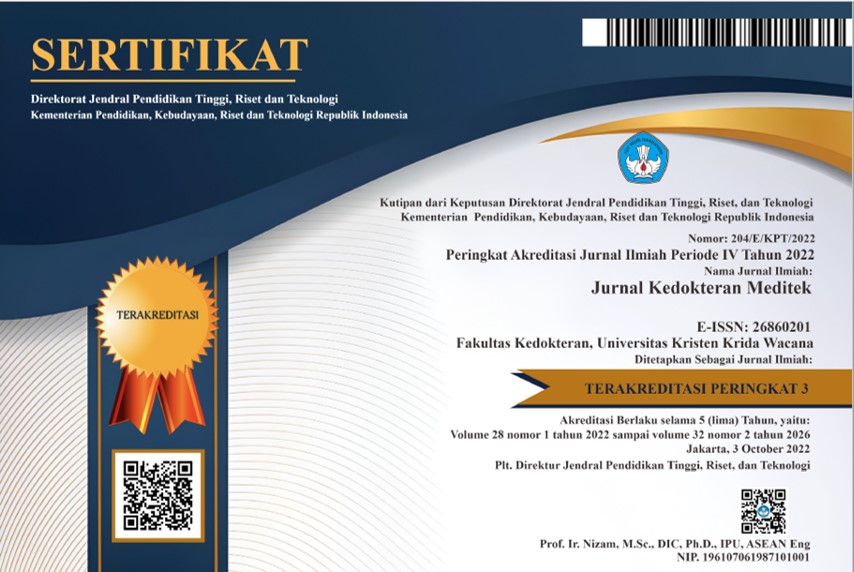Aktivitas Luar Ruangan Menghambat Pemanjangan Aksis Mata sebagai Pencegahan Miopia Progresif pada Anak
DOI:
https://doi.org/10.36452/jkdoktmeditek.v28i2.2303Keywords:
aktivitas, anak, miopia, pemanjangan aksisAbstract
Miopia paling sering disebabkan oleh Axial Length (AL) yang melebihi panjang rata-rata normal. Prevalensi miopia diprediksi akan mengalami peningkatan pada 2050. Peningkatan tersebut salah satunya disebabkan karena ada perubahan gaya hidup yang menyebabkan terjadi penurunan aktivitas di luar ruangan. Cahaya yang didapatkan pada aktivitas di luar ruangan merupakan faktor protektif yang dapat menghambat pemanjangan AL khususnya pada anak. Tinjauan Pustaka ini bertujuan untuk menggambarkan pengaruh aktivitas di luar ruangan terhadap AL anak pada penelitian yang dilakukan negara-negara lain untuk diterapkan pada populasi di Indonesia. Pencarian penelitian dilakukan pada ScienceDirect, PubMed, JAMA Network, dan Arvojournals dengan mengidentifikasi jurnal penelitian dari tahun 2012-2021. Tinjauan Pustaka ini menggunakan pedoman Preferred Reporting for Systematic Review and Meta-analysis (PRISMA). Didapatkan tujuh penelitian kohort dan tiga penelitian eksperimen yang sesuai dengan kriteria inklusi. Dapat disimpulkan bahwa aktivitas di luar ruangan dapat menghambat pemanjangan AL pada anak namun perlu dilakukan penelitian lanjutan dengan menggunakan intervensi tambahan berupa aktivitas di luar ruangan yang diukur dengan intensitas cahaya secara objektif pada anak dalam populasi lain khususnya di Indonesia.
References
Holden BA, Fricke TR, Wilson DA, Jong M, Naidoo KS, Sankaridurg P, et al. Global prevalence of myopia and high myopia and temporal trends from 2000 through 2050. Ophthalmology. 2016;123(5):1036–42.
Alvarez-Peregrina C, Martinez-Perez C, Villa-Collar C, Andreu-Vázquez C, Ruiz-Pomeda A, Sánchez-Tena MÁ. Impact of COVID-19 home confinement in children’s refractive errors. Int J Environ Res Public Health. 2021;18(10):5347.
Wang J, Li Y, Musch DC, Wei N, Qi X, Ding G, et al. Progression of myopia in school-aged children after COVID-19 home confinement. JAMA Ophthalmol. 2021;139(3):293.
Riordan-Eva P, Augsburger JJ. Vaughan & Asbury’s general ophthalmology 19th edition. 19th ed.New York: Mc Graw-Hill Education, 2018. p. 905–10.
Recko M, Stahl ED . Childhood myopia: epidemiology, risk factors, and prevention. Mo Med. 2015;112(2):116–21.
Moher D, Liberati A, Tetzlaff J, Altman DG. Preferred reporting items for systematic reviews and meta-analyses: the PRISMA statement. BMJ. 2009;339(7716):332–6.
Page MJ, Moher D, Bossuyt PM, Boutron I, Hoffmann TC, Mulrow CD, et al. PRISMA 2020 explanation and elaboration: updated guidance and exemplars for reporting systematic reviews. BMJ. 2021;372:n160.
Sterne JAC, Savović J, Page MJ, Elbers RG, Blencowe NS, Boutron I, et al. RoB 2: a revised tool for assessing risk of bias in randomised trials. BMJ. 2019;366:l4898.
McGuinness LA, Higgins JPT. Risk-of-bias VISualization (robvis): an R package and shiny web app for visualizing risk-of-bias assessments. Res Synth Methods. 2021;12(n/a):55–61.
Donovan L, Sankaridurg P, Ho A, Chen X, Lin Z, Thomas V, et al. Myopia progression in Chinese children is slower in summer than in winter. Optom Vis Sci. 2012;89(8):1196–202.
Guo Y, Liu LJ, Xu L, Tang P, Lv YY, Feng Y, et al. Myopic shift and outdoor activity among primary school children: one-year follow-up study in Beijing. Rendon A, editor. PLoS One. 2013;8(9):e75260.
Read SA, Collins MJ, Vincent SJ. Light exposure and eye growth in childhood. Investig Opthalmology Vis Sci. 2015;56(11):6779.
Guo Y, Liu LJ, Tang P, Lv YY, Feng Y, Xu L, et al. Outdoor activity and myopia progression in 4-year follow-up of Chinese primary school children: The Beijing Children Eye Study. Frishman L, editor. PLoS One. 2017;12(4):e0175921.
Ostrin LA, Sajjadi A, Benoit JS. Objectively measured light exposure during school and summer in children. Optom Vis Sci. 2018;95(4):332–42.
Sánchez-Tocino H, Gómez AVC, Bolaños GI, Alonso AA, Alvarez VM, Zamora G. et al.
The effect of light and outdoor activity in natural lighting on the progression of myopia in children. J Fr Ophtalmol. 2019;42(1):2–10.
Jiang D, Lin H, Li C, Liu L, Xiao H, Lin Y, et al. Longitudinal association between myopia and parental myopia and outdoor time among students in Wenzhou: a 2.5-year longitudinal cohort study. BMC Ophthalmol. 2021;21(1):11.
He M, Xiang F, Zeng Y, Mai J, Chen Q, Zhang J, et al. Effect of time spent outdoors at school on the development of myopia among children in China. JAMA. 2015;314(11):1142.
Jin J-X, Hua W-J, Jiang X, Wu X-Y, Yang J-W, Gao G-P, et al. Effect of outdoor activity on myopia onset and progression in school-aged children in Northeast China: the Sujiatun eye care study. BMC Ophthalmol. 2015;15(1):73.
Wu P-C, Chen C-T, Lin K-K, Sun C-C, Kuo C-N, Huang H-M, et al. Myopia prevention and outdoor light intensity in a school-based cluster randomized trial. Ophthalmology. 2018;125(8):1239–50.
Zhou X, Pardue MT, Iuvone PM, Qu J. Dopamine signaling and myopia development: what are the key challenges. Prog Retin Eye Res. 2017;61:60–71.
Troilo D, Smith EL, Nickla DL, Ashby R, Tkatchenko A V, Ostrin LA, et al. IMI – Report on experimental models of emmetropization and myopia. Investig Opthalmology Vis Sci. 2019;60(3):M31.
Torii H, Kurihara T, Seko Y, Negishi K, Ohnuma K, Inaba T, et al. Violet light exposure can be a preventive strategy against myopia progression. EBioMedicine. 2017;15:210–9.
Ojaimi E, Rose KA, Smith W, Morgan IG, Martin FJ, Mitchell P. Methods for a population-based study of myopia and other eye conditions in school children: The Sydney Myopia Study. Ophthalmic Epidemiol. 2005;12(1):59–69.
Spillmann L. Stopping the rise of myopia in Asia. Graefe’s Arch Clin Exp Ophthalmol. 2020;258(5):943–59.
Pan C-W, Wu R-K, Li J, Zhong H. Low prevalence of myopia among school children in rural China. BMC Ophthalmol. 2018;18(1):140.
Downloads
Published
How to Cite
Issue
Section
License
Copyright (c) 2022 Victor Setiawan Tandean, Maria Jessica Rachman, Casey Clarissa Gondo, Yasmine Putri Fadhilah

This work is licensed under a Creative Commons Attribution-NonCommercial-ShareAlike 4.0 International License.

















